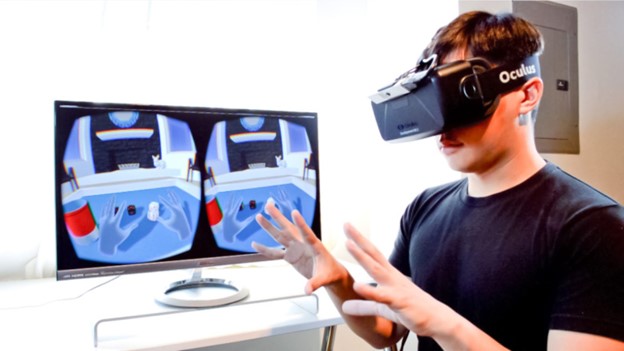Not so long ago, terms like augmented reality (AR) and virtual reality (VR) used to be considered futuristic and rare. Today, they are very much a part of our daily lives. But while they sound similar, these technologies have some contrasting points which can make them different concepts altogether. So, let’s check out the biggest differences between AR and VR along with their Purpose and Applications.
Virtual Reality

Virtual reality (VR) refers to a simulated experience in which the real world is replaced by a virtual environment. Through wearing a VR headset, users enter into a computer-generated reality wherein they can interact and be transported to another location or environment with relative realism. The technology creates an illusion of presence where individuals believe that their body is located elsewhere.
How Does Virtual Reality Work?
A VR headset contains a display screen together with motion sensors. When used, the display screen covers the field of vision, obscuring everything around one within a subject’s surroundings. The motion sensors within track the user via movement. The visual stimulation coupled with audio and movement tracking provides a complete sense of experience.
Applications of Virtual Reality
Virtual reality is currently most used in gaming. VR technology enables users to engage with interactive virtual worlds. Gamers are placed inside the game and they can experience it in a completely different way. Of course, it is impossible to transform all games into VR, but first-person games such as No Man’s Sky and Counter-Strike are the perfect candidates. Gamers can experience those games in a completely different manner like they are actually there.
In the field of education and training, VR is utilized for simulations and training programs in various sectors such as medicine, aviation, and the military. This technology provides a safe and controlled environment for learners to practice and gain experience before applying their skills in real-world situations, helping them develop the necessary skills and knowledge.
In architecture and design, professionals use VR to create effective walkthroughs and virtual representations of buildings and environments. This enables clients to experience and visualize the proposed designs before construction begins, providing valuable insights and facilitating effective communication between architects and clients.
Augmented Reality

Augmented reality (AR) can be defined as a technology that adds digital information and virtual objects to the real-world environment. Unlike virtual reality (VR), AR does not replace the real world but enhances it by adding virtual elements to the user’s surrounding environment. AR can be experienced through different devices, such as smartphones, tablets, and even smart glasses.
How Does Augmented Reality Work?
By using computer vision, sensors, and cameras, AR recognizes what the user sees in front of him or her and overlays the digital content accordingly. Augmented reality combines the real-world view captured by the device’s camera with computer-generated graphics to create an interactive and augmented experience. Through these interactions, the users see and interact with the virtual objects while still acknowledging their real-world surroundings.
Applications of Augmented Reality
Just like VR, AR is also mostly used for gaming and entertainment. Probably the most famous use case scenario is in Pokemon Go, a game where players can collect virtual monster characters by walking around in the real world. Virtual Pokemns are only seen on mobile screens, but they blend with the environment and it actually looks like they are right in front of you.
In addition to gaming, augmented reality (AR) technology revolutionizes the retail and e-commerce industry by allowing customers to visualize products in real-time. For example, customers can try on virtual clothing or place virtual furniture in their living space to see how it fits and looks before making a purchase decision.
When it comes to navigation and wayfinding, AR-powered navigation apps play a significant role in assisting users with unfamiliar environments. By overlaying directions and information onto the real-world view, these apps provide users with augmented reality guidance, making it easier to navigate and find their way.
AR vs VR: Key Differences
While AR and VR share the goal of enhancing user experiences, there are key differences between the two:
- Immersion: VR aims to create a fully immersive experience by replacing the real world with a virtual environment. AR, on the other hand, overlays virtual content in the real world, allowing users to maintain awareness of their surroundings.
- Interaction: In VR, users interact primarily with the virtual environment, often using handheld controllers or motion-tracking systems. AR enables users to interact with both the real world and virtual objects simultaneously.
- Device Requirements: VR typically requires dedicated headsets, such as Oculus Rift or HTC Vive. AR can be experienced through smartphones, tablets, or specialized AR glasses.
- Applications: VR is commonly used in gaming, simulations, and entertainment, providing users with virtual experiences. AR has diverse applications, including gaming, retail, navigation, and industrial sectors, by overlaying virtual elements onto the real world.
The Future of AR and VR
AR and VR technologies are still evolving and providing new horizons. Reactivity to hardware, software, and content creation is advancing brand-new emergences. Over time, we can anticipate that they will gradually be integrated into various facets of our lives; ranging from communication and entertainment to education and healthcare.
Conclusion
Augmented reality (AR) and virtual reality (VR) are advanced technologies that will dramatically change how we interact with digital content and the world around us. While VR puts users in a completely new environment, AR enhances the real world by adding digitally overlaid information.
Although used for different applications both of these advanced technologies have created an entirely new area of innovation as well as the conceptual new experience which has enabled many industries to be shaped. As advancement continues through the levels of technology they too will continue to evolve and offer thrilling opportunities for innovation.
I'm a published author and proud US Army veteran who happens to be a gamer, so I decided to combine the two and love every minute of it! Feel free to contact me with any questions or comments and I'll be sure to get back to you.





More Stories
Halloween Comes to GORN 2 with Fight of the Living Dead Update
PAX East 2025 Day 1 Impressions: Tunnels VR
Eldramoor: Haven in the Mist Fantasy VR MMORPG Launching Soon on Kickstarter